| Established | 1980 |
|---|---|
| Research type | Basic nuclear science |
Field of research | Radioactive waste management, nuclear fuel cycle back end analysis and radioisotope production |
| Location | Inshas, Egypt |
Operating agency | Egyptian Atomic Energy Authority |
The Hot Laboratory and Waste Management Center (HLWMC), is dedicated for radioactive waste disposal as well as development of expertise in the back end of nuclear fuel cycle and radioisotope production for medical and industrial applications. The HLWMC was established in 1980, owned and operated by the Egyptian Atomic Energy Authority (AEA) in Inshas, northeast of Cairo. [1] [2]
The Hot Laboratory and Waste Management Center (HLWMC) consists of a low and intermediate level liquid waste station, radioisotope production laboratories, and a radioactive waste disposal site. [1] [3] HLWMC contains a French-supplied hot cell complex for plutonium extraction research, which is the only known facility in Egypt that could be used to separate weapons-usable plutonium from irradiated reactor fuel. However, the facility does not contain nuclear materials requiring IAEA safeguards. [2] [3]

Radioactive waste is a type of hazardous waste that contains radioactive material. Radioactive waste is a result of many activities, including nuclear medicine, nuclear research, nuclear power generation, nuclear decommissioning, rare-earth mining, and nuclear weapons reprocessing. The storage and disposal of radioactive waste is regulated by government agencies in order to protect human health and the environment.

Nuclear reprocessing is the chemical separation of fission products and actinides from spent nuclear fuel. Originally, reprocessing was used solely to extract plutonium for producing nuclear weapons. With commercialization of nuclear power, the reprocessed plutonium was recycled back into MOX nuclear fuel for thermal reactors. The reprocessed uranium, also known as the spent fuel material, can in principle also be re-used as fuel, but that is only economical when uranium supply is low and prices are high. Nuclear reprocessing may extend beyond fuel and include the reprocessing of other nuclear reactor material, such as Zircaloy cladding.
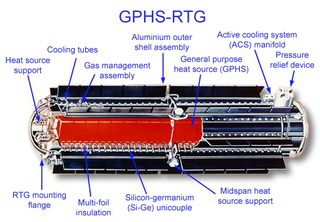
A radioisotope thermoelectric generator, sometimes referred to as a radioisotope power system (RPS), is a type of nuclear battery that uses an array of thermocouples to convert the heat released by the decay of a suitable radioactive material into electricity by the Seebeck effect. This type of generator has no moving parts. Because they don't need solar energy, RTGs are ideal for remote and harsh environments for extended periods of time, and because they have no moving parts, there is no risk of parts wearing out or malfunctioning.

Sellafield, formerly known as Windscale, is a large multi-function nuclear site close to Seascale on the coast of Cumbria, England. As of August 2022, primary activities are nuclear waste processing and storage and nuclear decommissioning. Former activities included nuclear power generation from 1956 to 2003, and nuclear fuel reprocessing from 1952 to 2022.

The Baghdad Nuclear Research Facility adjacent to the Tuwaitha "Yellow Cake Factory" or Tuwaitha Nuclear Research Center contains the remains of nuclear reactors bombed by Iran in 1980, Israel in 1981 and the United States in 1991. It was used as a storage facility for spent reactor fuel and industrial and medical wastes. The radioactive material would not be useful for a fission bomb, but could be used in a dirty bomb. Following the 2003 invasion of Iraq, the facility was heavily looted by hundreds of Iraqis, though it is unclear what was taken.
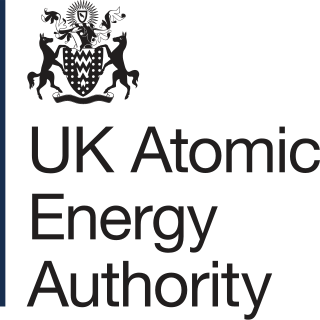
The United Kingdom Atomic Energy Authority is a UK government research organisation responsible for the development of fusion energy. It is an executive non-departmental public body of the Department for Energy Security and Net Zero (DESNZ).

The Waste Isolation Pilot Plant, or WIPP, is the world's third deep geological repository licensed to store transuranic radioactive waste for 10,000 years. The storage rooms at the WIPP are 2,150 feet underground in a salt formation of the Delaware Basin. The waste is from the research and production of United States nuclear weapons only. The plant started operation in 1999, and the project is estimated to cost $19 billion in total.

The Savannah River Site (SRS) is a U.S. Department of Energy (DOE) reservation in the United States in the state of South Carolina, located on land in Aiken, Allendale, and Barnwell counties adjacent to the Savannah River, 25 miles (40 km) southeast of Augusta, Georgia. The site was built during the 1950s to refine nuclear materials for deployment in nuclear weapons. It covers 310 square miles (800 km2) and employs more than 10,000 people.

The Mayak Production Association is one of the largest nuclear facilities in the Russian Federation, housing a reprocessing plant. The closest settlements are Ozyorsk to the northwest and Novogornyi to the south.

A deep geological repository is a way of storing hazardous or radioactive waste within a stable geologic environment. It entails a combination of waste form, waste package, engineered seals and geology that is suited to provide a high level of long-term isolation and containment without future maintenance. This will prevent any radioactive dangers. A number of mercury, cyanide and arsenic waste repositories are operating worldwide including Canada and Germany and a number of radioactive waste storages are under construction with the Onkalo in Finland being the most advanced.
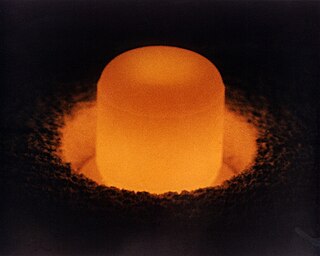
Plutonium-238 is a fissile, radioactive isotope of plutonium that has a half-life of 87.7 years.

Spent nuclear fuel, occasionally called used nuclear fuel, is nuclear fuel that has been irradiated in a nuclear reactor. It is no longer useful in sustaining a nuclear reaction in an ordinary thermal reactor and, depending on its point along the nuclear fuel cycle, it will have different isotopic constituents than when it started.
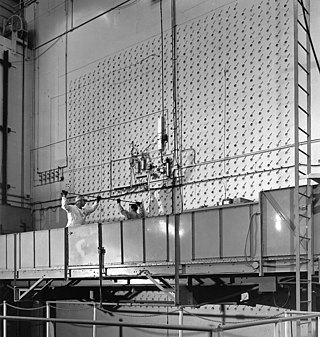
The X-10 Graphite Reactor is a decommissioned nuclear reactor at Oak Ridge National Laboratory in Oak Ridge, Tennessee. Formerly known as the Clinton Pile and X-10 Pile, it was the world's second artificial nuclear reactor, and the first designed and built for continuous operation. It was built during World War II as part of the Manhattan Project.
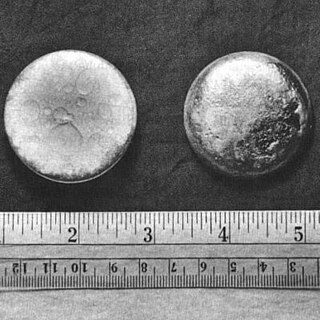
Plutonium is a radioactive chemical element with the symbol Pu and atomic number 94. It is an actinide metal of silvery-gray appearance that tarnishes when exposed to air, and forms a dull coating when oxidized. The element normally exhibits six allotropes and four oxidation states. It reacts with carbon, halogens, nitrogen, silicon, and hydrogen. When exposed to moist air, it forms oxides and hydrides that can expand the sample up to 70% in volume, which in turn flake off as a powder that is pyrophoric. It is radioactive and can accumulate in bones, which makes the handling of plutonium dangerous.

High-level radioactive waste management concerns how radioactive materials created during production of nuclear power and nuclear weapons are dealt with. Radioactive waste contains a mixture of short-lived and long-lived nuclides, as well as non-radioactive nuclides. There was reportedly some 47,000 tonnes of high-level nuclear waste stored in the United States in 2002.
President Adly Mansour announced on 7 November 2013 that Egypt was restarting its nuclear power program in El Dabaa; a deal was reached with the residents in which it was agreed that a residential area will also be built. The Egyptian minister of electricity, Ahmed Emam, has called the project "necessary" because of a small amount of renewable energy sources and not enough fuel.
ETRR-1 or ET-RR-1, is the first nuclear reactor in Egypt supplied by the USSR in 1958. The reactor is owned and operated by Egyptian Atomic Energy Authority (AEA) at the Nuclear Research Center in Inshas, 40–60 kilometres (25–37 mi) northeast of Cairo.
ETRR-2 or ET-RR-2, or is the second nuclear reactor in Egypt supplied by the Argentine company Investigacion Aplicada (INVAP) in 1992. The reactor is owned and operated by Egyptian Atomic Energy Authority (EAEA) at the Nuclear Research Center in Inshas, 60 kilometres (37 mi) northeast of Cairo.
The Hydrometallurgy Pilot Plant (HPP) is a hot cell laboratory complex, dedicated to perform bench-scale radiochemistry experiments including the separation of plutonium and uranium from the spent fuel rods of the ETRR-1 research reactor and was established in 1982. The HPP is owned and operated by the Egyptian Atomic Energy Authority (AEA) at the Nuclear Research Center in Inshas, northeast of Cairo.
Radioisotopes Production Facility (RPF), is a facility for the production of radioisotopes from irradiation of Low enriched uranium (LEU) in the Egyptian Second Research Reactor (ETRR-2) Complex. The RPF was supplied by the Argentine company Investigacion Aplicada (INVAP) and was commissioned during October and November 2011. The produced radioisotopes are used in medicine, industry and research activities for domestic market.